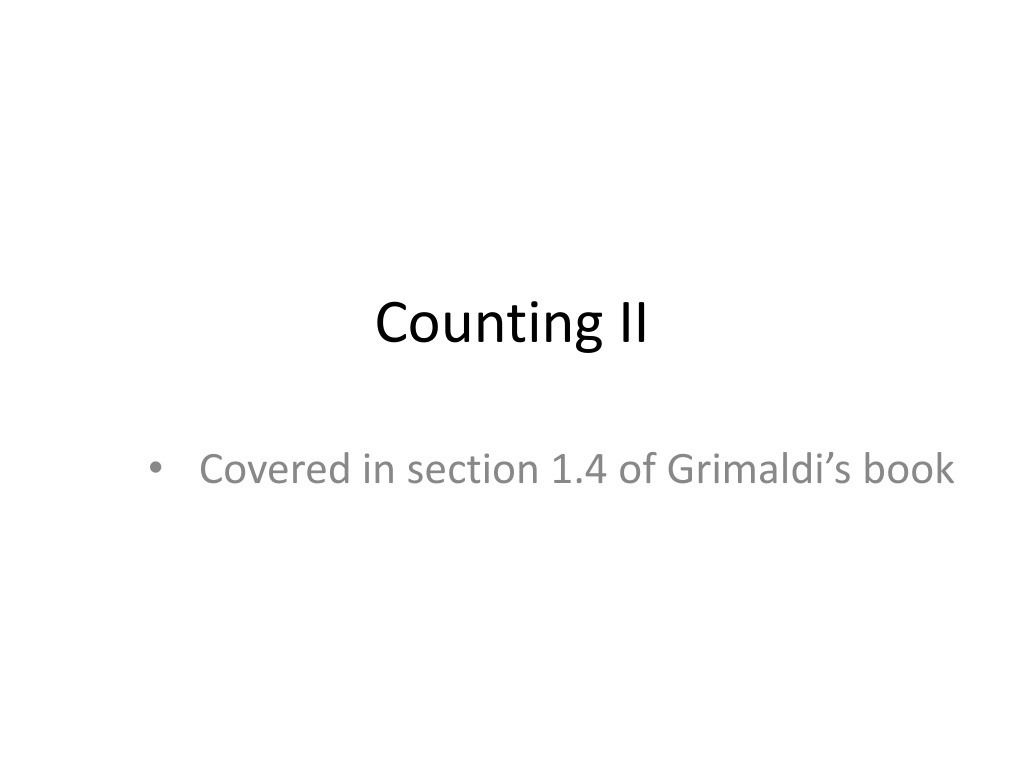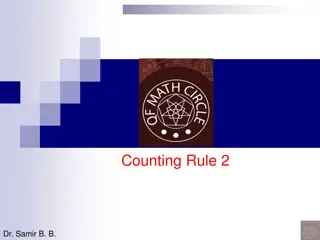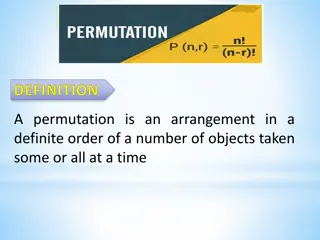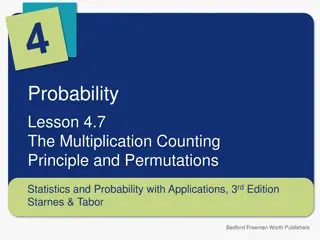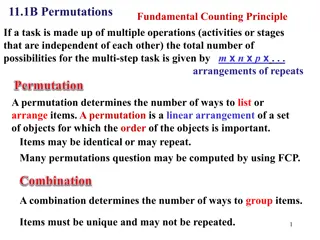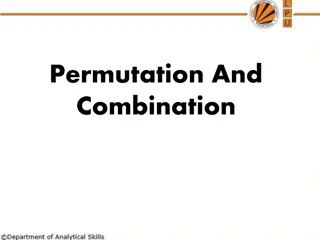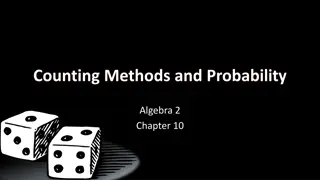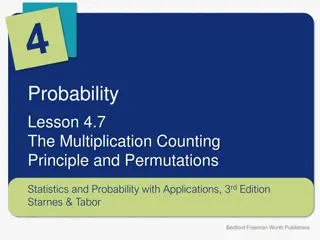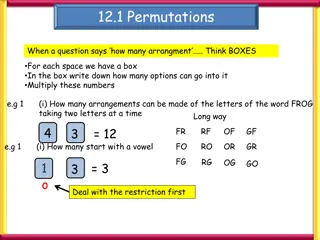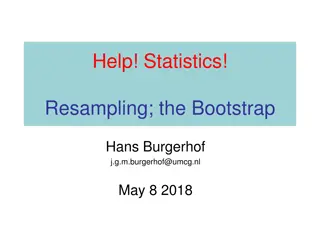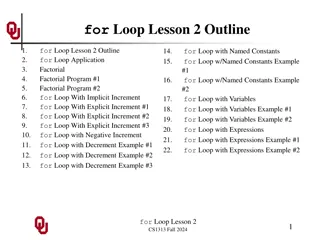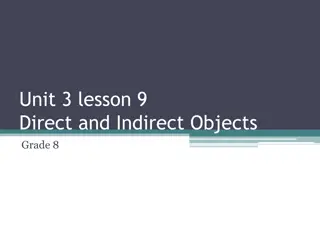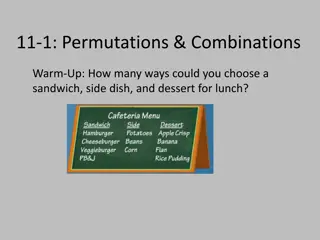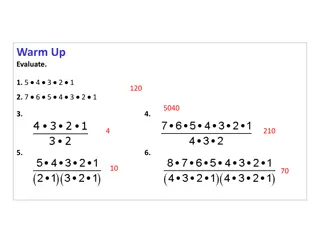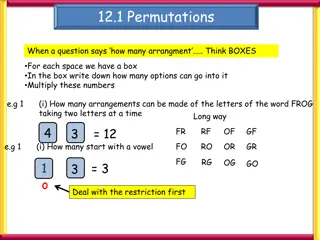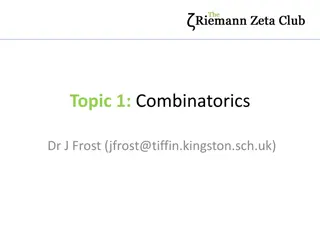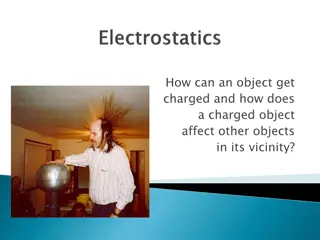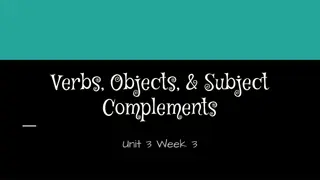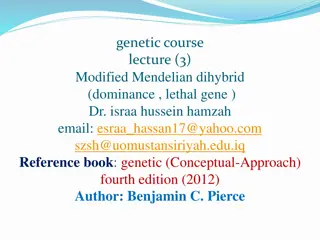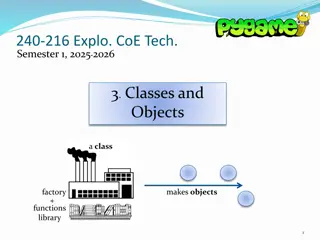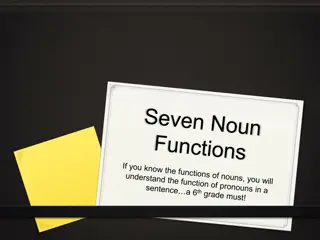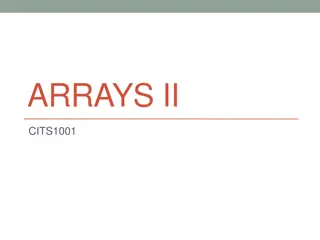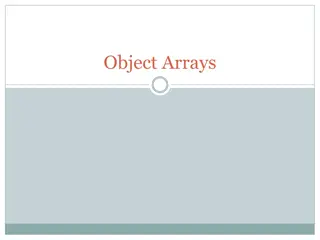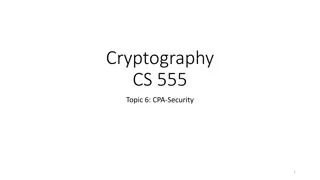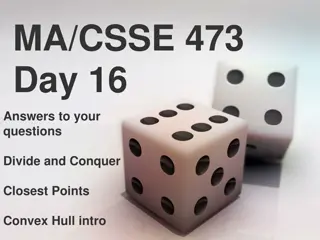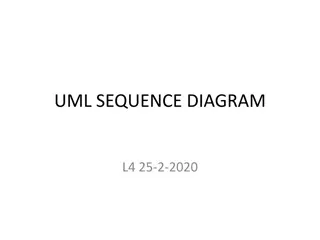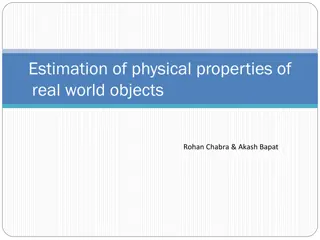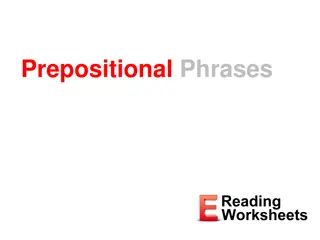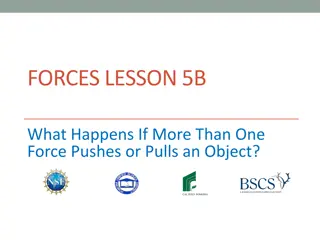Understanding Permutations with Indistinguishable Objects
Permutations of objects where some items are indistinguishable can be solved using different methods. One example includes reordering the letters of a word like "JESSEE." By identifying the distinct letters and applying combinatorial calculations, the number of unique permutations can be determined effectively.
Download Presentation

Please find below an Image/Link to download the presentation.
The content on the website is provided AS IS for your information and personal use only. It may not be sold, licensed, or shared on other websites without obtaining consent from the author. Download presentation by click this link. If you encounter any issues during the download, it is possible that the publisher has removed the file from their server.
E N D
Presentation Transcript
Counting II Covered in section 1.4 of Grimaldi s book
Permutations A r-permutations of a set of n objects is the same as a length-r lists. Here the order of the objects is important. The number of r-permutations of n objects with repetition is nr. The number of r-permutation of n objects without repetition is . We write
Permutations with indistinguishable objects Example: How many permutations one can make by reordering the letters of the word JESSEE ? (JESSEE and SJESEE are two different lists (permutations))
Permutations with indistinguishable objects Example: How many permutations one can make by reordering the letters of the word JESSEE ? (JESSEE and SJESEE are two different lists (permutations)) First Method: We first indicate 3 Es as E1, E2, E3and two Ss as S1, S2. Thus JESSEE can be written as JE1S1S2E2E3.
Permutations with indistinguishable objects Example: How many permutations one can make by reordering the letters of the word JESSEE ? (JESSEE and SJESEE are two different lists (permutations)) First Method: We first indicate 3 Es as E1, E2, E3and two Ss as S1, S2. Thus JESSEE can be written as JE1S1S2E2E3. If three Es and two Ss are treated as distinct, the number of 6- permutations is 6!. Note that JE1S1S2E2E3 and JE1S2S1E2E3are the same if two Ss are not distinct. The number of distinct permutations is
Permutations with indistinguishable objects Example: How many permutations one can make by reordering the letters of the word JESSEE ? (JESSEE and SJESEE are two different lists (permutations)) Second Method: The word JESSEE contains 3 Es, 2 Ss and one J.
Permutations with indistinguishable objects Example: How many permutations one can make by reordering the letters of the word JESSEE ? (JESSEE and SJESEE are two different lists (permutations)) Second Method: The word JESSEE contains 3 Es, 2 Ss and one J. We can place 3 Es in 6 places in C(6,3) different ways.
Permutations with indistinguishable objects Example: How many permutations one can make by reordering the letters of the word JESSEE ? (JESSEE and SJESEE are two different lists (permutations)) Second Method: The word JESSEE contains 3 Es, 2 Ss and one J. We can place 3 Es in 6 places in C(6,3) different ways. There are three more positions to fill once Es are placed.
Permutations with indistinguishable objects Example: How many permutations one can make by reordering the letters of the word JESSEE ? (JESSEE and SJESEE are two different lists (permutations)) Second Method: The word JESSEE contains 3 Es, 2 Ss and one J. We can place 3 Es in 6 places in C(6,3) different ways. There are three more positions to fill once Es are placed. In C(3,2) ways we can place 2Ss in three positions. After all these, J has one (C(1,1)) position to go.
Permutations with indistinguishable objects Example: How many permutations one can make by reordering the letters of the word JESSEE ? (JESSEE and SJESEE are two different lists (permutations)) Second Method: The word JESSEE contains 3 Es, 2 Ss and one J. We can place 3 Es in 6 places in C(6,3) different ways. There are three more positions to fill once Es are placed. In C(3,2) ways we can place 2Ss in three positions. After all these, J has one (C(1,1)) position to go. The total number of permutations of the letters of JESSEE is
Permutations with Some Repetitions Theorem: Suppose I have a collection of n objects: n1objects of type 1. n2objects of type 2. . nkobjects of type k. Where all the types are distinct, and n1+n2+ +nk=n Then, the number of distinct permutations of the n objects is n .... n n n n n n n n n ! n ...... 1 2 1 1 1 k = * * * n n n ! ! !.... ! n n n n 1 3 2 k 1 2 3 k
Permutations with indistinguishable objects Theorem: The number of different arrangements of n objects where there are n1objects of Type 1 (non- distinct), n2objects of Type 2 (non-distinct), ., nkobjects of Type k (non-distinct), and n1+ n2+ . + nk= n , is .
Combinations A r-combination of a set of n objects is an unordered selection of r elements from the set. When the elements are not repeated, a r-combination is a size- r subset. We have seen that
r-combinations with repetitions allowed A r-combination, with repetition allowed, chosen from a set X of n elements (distinct) is an unordered selection of elements taken from X, where repetitions are allowed. That is we can take several copies of any element of X in the selection.
Combinations with repetitions We consider the case when an object is selected repeatedly. Example: Consider a set A = {a,b,c,d}. We select two objects from A. We now consider the following four cases.
Given set of objects = {a,b,c,d} 2-permutations with repetitions: 42= 16 possible cases.
2-permutations without repetitions: P(4,2) = 12 possible cases.
2-combinations without repetitions: C(4,2) = 6 possible cases.
2-combinations with repetitions: C(5,3) = 10 possible cases.
2-combinations with repetitions: C(5,3) = 10 possible cases. Note that combinations with repetitions do not correspond to subsets of a set.
Combinations with repetitions We consider the case when an object is selected repeatedly. Example: Consider a set A = {a,b,c,d}. We select two 10 objects from A with repetitions. aaaabbbbbd (order is not important) selected a four times; selected b five times and selected d one time
Combinations with repetitions We consider the case when an object is selected repeatedly. Example: Consider a set A = {a,b,c,d}. We select two 10 objects from A with repetitions. aaaabbbbbd (order is not important) selected a four times; selected b five times and selected d one time bbbaaacccd (another combination)
Combinations with repetitions We consider the case when an object is selected repeatedly. Example: Consider a set A = {a,b,c,d}. We select two 10 objects from A with repetitions. aaaabbbbbd (order is not important) selected a four times; selected b five times and selected d one time bbbaaacccd (another combination) a b c d x x x x | x x x x x | x | a b c d x x x | x x x | x x x | x |
Combinations with repetitions We consider the case when an object is selected repeatedly. Example: Consider a set A = {a,b,c,d}. We select two 10 objects from A with repetitions. aaaabbbbbd (order is not important) selected a four times; selected b five times and selected d one time bbbaaacccd (another combination) a b c d x x x x | x x x x x | x | a b c d x x x | x x x | x x x | x | a b c d | x | x x x x x | x x x x another combination
Example Seven students where each of them has one item from: cheeseburger, hot dog, taco and fish sandwich. How many different purchases are possible? Some possible purchases:
Example Equivalent bar notation Thus we have to arrange 7 x s and (n-1) bars( | ). This is an arrangement of 10 objects using seven x and three |. This is This is the same as
Theorem: The number of r-combinations with repetition allowed, that can be selected from a set of size n is
Proof: . nth 2nd 3rd 1st XXX XX X r X s and n-1 boundaries. These can be arranged in any order. The number of ways this can be done is C(r+n-1,r) = C(r+n-1,n-1) = Thus the number of r-combinations with repetitions allowed is
Example I want to buy 5 cans of soft drink. The possible drinks that are available are coke, sprite and pepsi, where there are unlimited number of each. In how many ways can I choose the 5 cans? Answer: This is same as the number of 5-combinations, with repetition allowed, from a set of size 3. (since I need to select 5 cans from a set of size 3 with repetition allowed) Using the theorem, this can be done in + 5 3 1 5 ways.
Example Library has budget to buy 20 copies of books on discrete math. Five different text books on discrete math are available (unlimited number of copies) in the market. How many ways can the library buy the books? Answer: This is same as the number of 20-combinations, with repetition allowed, from a set of size 5. (since I need to select 20 books from a set of size 5 with repetition allowed) Using the theorem, this can be done in 20 + 20 5 1 ways.
Example How many integral solutions of equation x1+x2+x3=20, where x1,x2,x3 0 are there? Answer: Note that we can consider x1, x2, x3 as different types. Choosing xi=t, would mean that we are taking t copies of xi. This is same as the number of 20-combinations, with repetition allowed, from a set of objects of size 3. Using the theorem, this can be done in + 20 20 3 1 ways.
Permutations and combinations with and without repetitions. n = Number of objects r = number of objects to be selected
Balls in Boxes Many problems can be formulated as a balls in boxes problem. Suppose we have r balls which are to be placed in n boxes. Balls are distinguishable (distinct) or not? Boxes are distinguishable (distinct) or not? Boxes have limited capacity or infinite capacity? Boxes are required to be non-empty?
Balls in Boxes We will only consider the cases where Boxes are distinguishable. The question when boxes are indistinguishable is hard. Case I: r distinguishable balls are to be placed in n distinguishable boxes with infinite capacity. We can divide the job into r tasks. Ti: place the i-th ball. (i=1 to r) Ti can be done in n ways (one can select any of the boxes). Using the multiplication rule, number of ways to do the job is nr.
Balls in Boxes Case II: r indistinguishable balls are to be placed in n distinguishable boxes with infinite capacity. n th 3rd 2nd . 1st XXX XX X Choosing r-combination from a set of size n with repetition allowed. This can be done in ways by the theorem done earlier.
Balls in Boxes Case III: r distinguishable balls are to be placed in n distinguishable boxes with capacity =1. n < r 0 ways n r P(n,r) ways
Balls in Boxes Case IV: r indistinguishable balls are to be placed in n distinguishable boxes with capacity =1. n < r 0 ways n r ways
Balls in Boxes: non-empty boxes. Case V: r indistinguishable balls are to be placed in n distinguishable boxes, with unlimited capacity such that each box is non-empty. r < n: 0 ways. r n Give one ball to each box. Now distribute the remaining r-n balls in n boxes, without the non-empty constraint.
Balls in Boxes: non-empty boxes. Case VI: r indistinguishable balls are to be placed in n distinguishable boxes, with capacity = 1, such that each box is non-empty. If r = n: 1 way. If r n : 0 way.
It is important to recognize the equivalence of the following The number of integer solutions of the equation x1 + x2+ + xn = r where xi 0 for all 1 i n. The number of choices, with repetitions, of size r from a collection of n objects. The number of choices of distributing r indistinguishable balls to n bins with no restriction (i.e. a bin can get no ball). The number of ways of placing r indistinguishable balls in n distinct bins. Total number of integral solutions = C(r+n-1, n-1)
Example A doughnut shop has plain doughnuts, cherry doughnuts, chocolate doughnuts, almond doughnuts, apple doughnuts, broccoli doughnuts. How many ways are there to choose: (a) a dozen doughnuts?
Example A doughnut shop has plain doughnuts, cherry doughnuts, chocolate doughnuts, almond doughnuts, apple doughnuts, broccoli doughnuts. How many ways are there to choose: (a) a dozen doughnuts? 12 indistinguishable balls and 6 bins Ans: C(12+6-1,6-1) = C(17,5) = C(17, 12)
Example A doughnut shop has plain doughnuts, cherry doughnuts, chocolate doughnuts, almond doughnuts, apple doughnuts, broccoli doughnuts. How many ways are there to choose: (b) three dozen doughnuts?
Example A doughnut shop has plain doughnuts, cherry doughnuts, chocolate doughnuts, almond doughnuts, apple doughnuts, broccoli doughnuts. How many ways are there to choose: (b) three dozen doughnuts? 36 doughnut 36 indistinguishable balls and 6 bins Ans: C(36+6-1,6-1) = C(41,5) = C(41,36)
Example A doughnut shop has plain doughnuts, cherry doughnuts, chocolate doughnuts, almond doughnuts, apple doughnuts, broccoli doughnuts. How many ways are there to choose: (c) two dozen doughnuts with at least two of each kind?
Example A doughnut shop has plain doughnuts, cherry doughnuts, chocolate doughnuts, almond doughnuts, apple doughnuts, broccoli doughnuts. How many ways are there to choose: (c) two dozen doughnuts with at least two of each kind? Pick first two of each kind . Thus the answer is the number of ways of choosing the remaining dozen. Same as question (a).
Example A doughnut shop has plain doughnuts, cherry doughnuts, chocolate doughnuts, almond doughnuts, apple doughnuts, broccoli doughnuts. How many ways are there to choose: (d) two dozen doughnuts with no more than two broccoli doughnuts?
Example A doughnut shop has plain doughnuts, cherry doughnuts, chocolate doughnuts, almond doughnuts, apple doughnuts, broccoli doughnuts. How many ways are there to choose: (d) two dozen doughnuts with no more than two broccoli doughnuts? We will add up three cases: no broccoli doughnut, exactly one broccoli doughnut, exactly two broccoli doughnuts. These numbers are: C(24 +5 -1, 5-1) (0 broccoli doughnut); C(23 +5-1, 5-1) (1 broccoli doughnut); C(22+5-1,5-1) (2 broccoli doughnuts)
Example A doughnut shop has plain doughnuts, cherry doughnuts, chocolate doughnuts, almond doughnuts, apple doughnuts, broccoli doughnuts. How many ways are there to choose: (e) two dozen doughnuts at least five chocolate doughnuts and at least three almond doughnuts?
